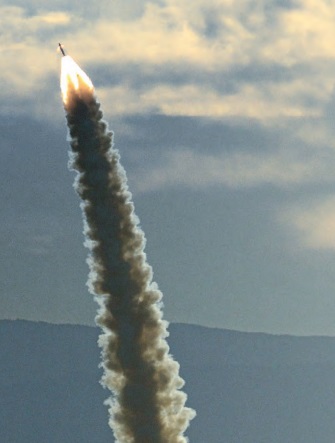Chapter: Engineering Successes, new invention technology, Research project papers,
Abort!...In the Event of an Emergency

Abort!...In the Event of an Emergency
The Orion Abort Flight Test (AFT) team at Armstrong led the
vehicle integration and operations effort for the Orion Pad Abort 1 (PA-1)
flight test, which occurred at the White Sands Missile Range (WSMR) in May
2010. PA-1 was the first fully integrated flight test of the Launch Abort
System (LAS), one of the primary systems within the Orion Multi-Purpose Crew
Vehicle (MPCV). The LAS provides the crew with an escape capability in the
unlikely event of an emergency on the launch pad or during mission vehicle ascent.
While the Orion Crew Module (CM) was at Armstrong, engineers and technicians
installed instrumentation, electrical wiring, computer systems, avionics,
parachutes, thermal ducting, acoustic blankets, and a GPS/inertial navigation
system. Vibration and acoustics tests of the Orion CM assessed the effects of
an abort motor firing on both the structure and internal electronics. A
combined systems test verified the flight readiness of the flight control,
antenna, pyrotechnic, and ground control systems.
After the Orion CM was
transferred to WSMR, Armstrong expanded its lead of the integration and
operations effort, mating the Orion CM with the Orion LAS, followed by the
mission operations activity for the highly successful PA-1 flight test.
Work to date: The Orion PA-1
Flight-Test Vehicle integration and operations effort required a
significant contribution from the Armstrong workforce, and ultimately
culminated in the successful demonstration of an abort capability from the
launch pad. Information learned during PA-1 will help certify and refine the
LAS design for future human spaceflight missions.
Looking ahead: The Orion LAS is a
primary system within the Orion MPCV, which is now part of the NASA
Space Launch System (SLS) architecture. The SLS will be used to transport
astronauts to
destinations beyond
low Earth orbit. Future flight testing (beyond PA-1) will ensure abort
capability for the SLS.
Partners: NASA's Johnson Space
Center, Langley Research Center, and Marshall Space Flight Center
and the Lockheed Martin Corporation
Engineering Successes
Armstrong's Research and Engineering Directorate is responsible
for the overall engineering content of flight research projects. Our engineers
provide technical expertise in aerodynamics; guidance, navigation, and control;
propulsion; static and dynamic structures; flight hardware and software; flight
and ground test instrumentation and data systems; and system engineering and
integration. They apply their expertise across the spectrum of Armstrong's many
activities and also support the development and continual evolution of
engineering tools and test techniques. Here are highlights from a few recent
and particularly notable engineering success stories.
Related Topics